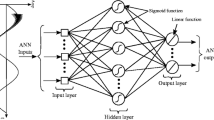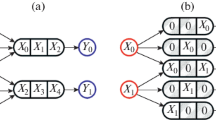Abstract
In this paper, different neural network-based solutions to the contingency analysis problem are presented. Contingency analysis is examined from two perspectives: as a functional approximation problem obtaining a numerical evaluation and ranking contingencies; and as a graphical monitoring problem, obtaining an easy visualization system of the relative severity of the contingencies. For the functional evaluation problem, we analyze the use of different supervised feed-forward artificial neural networks (multilayer perceptron and radial basis function networks). The proposed systems produce a very accurate evaluation and ranking, and so present a high applicability. For the graphical monitoring problem, unsupervised artificial neural networks such as self-organizing maps by Kohonen have been used. This solution allows both a rapid, easy and simultaneous visualization of the severity level of the complete contingency set. The proposed solutions avoid the main drawbacks of previous neural network approaches to this problem, which are explicitly analyzed here.






Similar content being viewed by others
References
Warwick K, Ekwue A, and Aggarwal R (eds) (1997) Artificial intelligence techniques in power systems. IEE Power Engineering Series 22. The Institution of Electrical Engineers press, New York
Vaahedi E, Fuchs C, Xu W, Mansour Y, Hamadanizadeh H, Morison G (1999) Voltage stability contingency screening and ranking. IEEE Trans Power Syst 14(1):256–265. doi:10.1109/59.744541
Monticelli A, Garcia A, Saavedra OR (1990) Fast decoupled load flow: hypothesis, derivations, and testing. IEEE Trans Power Syst 5(4):1425–1431. doi:10.1109/59.99396
Mori H, Tanaka H, Kanno J (1996) A preconditioned fast decoupled power flow method for contingency screening. IEEE Trans Power Syst 11(1):357–363. doi:10.1109/59.486118
Granelli GP, Montagna M, Pasini GL, Marannino P (1992) Vector computer implementation of power flow outage studies. IEEE Trans Power Syst 7(2):798–804. doi:10.1109/59.141788
Wang L, Lin XR (2000) Robust fast decoupled power flow. IEEE Trans Power Syst 15(1):208–215. doi:10.1109/59.852123
Ejebe GC, Meeteren HPV, Wollenberg BF (1988) Fast contingency screening and evaluation for voltage security analysis. IEEE Trans Power Syst 3(4):302–307. doi:10.1109/59.192968
Lemaître C, Thomas B (1996) Two applications of parallel processing in power system computation. IEEE Trans Power Syst 11(1):246–253. doi:10.1109/59.486102
Santos JR, Expósito AG, Ramos JLM (1999) Distributed contingency analysis: practical issues. IEEE Trans Power Syst 14(4):1349–1354. doi:10.1109/59.801895
Fujiwara R, Sakaguchi T, Kohno Y, Suzuki H (1986) An intelligent load flow engine for power system planning. IEEE Trans Power Syst PAS-3:302–307. doi:10.1109/TPWRS.1986.4334998
Lo KL, Abdelaal AKI (2000) “Fuzzy logic based contingency analysis”, International Conference on Electric Utility Deregulation and Restructuring and Power Technologies 2000,City University, London, pp 499–504
Matos MA, Hatziargyriou ND, Lopes JAP (2000) Multicontingency steady state security evaluation using fuzzy clustering techniques. IEEE Trans Power Syst 15(1):177–183. doi:10.1109/59.852118
Joya G, García-Lagos F, Atencia MA, Sandoval F (2004) Artificial neural networks for energy management system. Applicability and limitations of the main paradigms. Eur J Econ Soc Syst 17(1–2):11–28
Tang SK, Dillon TS, Khosla R (1996) Application of an integrated fuzzy, knowledge-based, connectionistic architecture for fault diagnosis in power systems. In. Proc int conf intell syst appl power syst ISAP 96:188–193. doi:10.1109/ISAP.1996.501066
Refaee JA, Mohandes M, Maghrabi H (1999) Radial basis function networks for contingency analysis of bulk power systems. IEEE Trans Power Syst 14(2):772–778. doi:10.1109/59.761911
Yan HH, Chow JC, Kam M, Fischl R, Sepich CR (1991) Hybrid expert system neural network hierarchical architecture for classifying power system contingencies. In: Proceedings of the first international forum on applications of neural networks to power systems, pp 76–82
Sidhu TS, Cui L (2000) Contingency screening for steady-state security analysis by using FFT and artificial neural networks. IEEE Trans Power Syst 15(1):421–426. doi:10.1109/59.852154
García-Lagos F, Joya G, Marín FJ, Sandoval F (2001) Neural networks for contingency evaluation and monitoring in power systems. In: Mira J, Prieto A (eds) Bio-inspired applications of connectionism, LNCS 2085. Springer-Verlag, Berlin, pp 711–718
Jollife IT (1986) Principal component analysis. Springer, New York
Jackson JE (1991) A user’s guide to principal components. Wiley, New York
Hagan MT, Menhaj MB (1994) Training feedforward networks with the Marquardt algorithm. IEEE Trans Neural Netw 4(6):989–993. doi:10.1109/72.329697
Tibshirani R (1996) A comparison of some error estimates for neural network models. Neural Comput 8:152–163. doi:10.1162/neco.1996.8.1.152
Chen S, Cowan CFN, Grant PM (1991) Orthogonal least squares learning algorithm for radial basis function networks. IEEE Trans Neural Netw 2(2):302–309. doi:10.1109/72.80341
García-Lagos F, Joya G, Marín FJ, Sandoval F (2002) Self-organizing maps for contingency analysis: visual classification and temporal evolution. In: Proc. of conference of the IEEE industrial electronics society, Sevilla, 2002
Haykin S (1994) Neural networks. a comprehensive foundation. Macmillan College Publishing Company, New York
Cottrell M (2003) Some other applications of the SOM algorithm: how to use the Kohonen algorithm for forecasting. In: Invited lecture at the international work-conference on artificial neural networks, IWANN 2003, Vilanova i La Geltrú (Spain), (ftp://samos.univ-paris1.fr/pub/SAMOS/preprints/samos185.pdf)
Cottrell M, Rousset P, Girad B, Girad Y (1995) Daily electric power curves: classification and forecasting using a Kohonen map. In: Mira J, Sandoval F (eds) From natural to artificial neural computation, LNCS 930. Springer, Berlin, pp 1107–1113
Acknowledgments
Authors acknowledge the interesting comments and suggestions of the reviewers. This work has been partially supported by the Spanish Ministerio de Educación y Ciencia (MEC), project no. TIN2005-01359.
Author information
Authors and Affiliations
Corresponding author
Rights and permissions
About this article
Cite this article
Joya, G., García-Lagos, F. & Sandoval, F. Contingency evaluation and monitorization using artificial neural networks. Neural Comput & Applic 19, 139–150 (2010). https://doi.org/10.1007/s00521-009-0267-x
Received:
Accepted:
Published:
Issue Date:
DOI: https://doi.org/10.1007/s00521-009-0267-x




